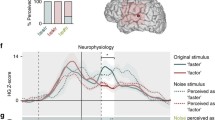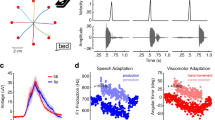Abstract
Masking in motor systems was defined as the omission of one act in a sequence due to an earlier or later act in the sequence. A study of phoneme omission in natural speech showed that:
-
1.
Masked phonemes were usually preceded or followed by an identical phoneme (referred to as the masking phoneme).
-
2.
Backward masking, where the masked phoneme preceded the masking phoneme was as frequent as forward masking.
-
3.
The phonemes immediately adjacent to the masked and masking phonemes were usually similar in distinctive features, but rarely identical.
-
4.
The masking phoneme usually occurred in a stressed syllable and the masked phoneme in an unstressed one, suggesting that motor intensity may be a factor in masking.
-
5.
The components for an adequate model of motor masking were shown to be similar to those in models of other types of errors in speech.
Similar content being viewed by others
References
Alpern, M.: Metacontrast. J. opt. Soc. Amer. 43, 648–657 (1953).
Breul, K. (ed.): German and English dictionary. Boston: Heath & Co. 1906.
Brown, R., and D. McNeil: The tip of the tongue phenomenon. J. verb. learn. Verb. behav. 5, 325–337 (1966).
Bullock, T. H.: Mechanisms of integration in Bullock et al.: Structure and function in the nervous systems of invertebrates. London: Freeman 1965.
Evarts, E.V.: Relation of pyramidal tract activity to force exerted during voluntary movement. J. Neurophysiol. 31, 14–27 (1968).
Heffner, R. M. S.: General phonetics. Madison: University of Wisconsin Press 1964.
Hubel, D. H., and T. N. Wiesel: Receptive fields, binocular interaction and functional architecture of the cat's visual cortex. J. Physiol. (Lond.) 160, 106–154 (1962).
—: Receptive field and functional architecture in two nonstriate visual areas of the cat. J. Neurophysiol. 28, 229–289 (1965).
Kahneman, D.: Method, findings and theory in studies of visual masking. (Forthcoming.)
Lashley, K. S.: The problem of serial order in behavior. In: S. Saporta (ed.), Readings in psycholinguistics. New York: Holt, Rinehart, Winston 1961.
MacKay, D. G.: Spoonerisms: The anatomy of an error in the serial order of behavior, 1969.
MacKay, D. G. The repeated letter effect in the spelling errors of normals and dysgraphics. Perception and psychophysics. (Forthcoming.)
MacKay, D. G. The structure of phoneme repetition in languages. Language and speech. (Forthcoming.)
Meringer, R.: Aus dem Leben der Sprache. Versprechen, Kindersprache, Nachahmungstrieb. Berlin: Behr's Verlag 1908.
—, u. K. Mayer: Versprechen und Verlesen: Eine Psychologisch-Linguistische Studie. Stuttgart: Goschensche Verlag 1895.
Müller, G. E., u. F. Schumann: Experimentelle Beiträge zur Untersuchung des Gedächtnisses. Z. Psychol. 6, 1–339 (1894).
Raab, D. H.: Backward masking. Psychol. Bull. 60, 118–129 (1963).
Ratliff, E.: Inhibitory interaction and the detection and enhancement of contours, p. 183–203, in: Sensory communication (W. A. Rosenblith, ed.). New York: Wiley 1961.
Robbins, S. D.: A dictionary of speech pathology and therapy. Cambridge, Mass.: Sci-Art. 1963.
Robinson, D. W.: Disinhibition of visually masked stimuli. Science 139, 154–158 (1966).
Ruch, T. C.: The cerebral cortex: its structure and motor functions. In: Ruch et al. (eds.), Neurophysiology, 2nd ed. Philadelphia: W. B. Saunders Co. 1965.
Sperling, G.: A model for visual memory tasks. Human Factors 5, 19–31 (1963).
Stetson, R. H.: Motor phonetics: A study of speech movements in action. Amsterdam: North Holland Publ. Co. 1951.
Sturtevant, E. H.: Linguistic science. New Haven: Yale University Press 1947.
Teuber, H. L.: Perception. In: Field et al. (eds.), Handbook of Physiology III Neurophysiology, chap. 65, p. 1595–1668. New York: Williams and Wilkins 1958.
Vince, M. A.: The intermittency of control of movements and the psychological refractory period. Brit. J. Psychol. 38, 149–157 (1948).
Wickelgren, W. A.: Distinctive features and errors in shortterm memory for English consonants. J. acoust. Soc. Amer. 39, 388–398 (1966).
—: Associative intrusions in short-term recall. J. exp. Psychol. 72, 853–858 (1966).
Wickelgren, W. A. Context-sensitive coding, associative memory, and serial order in (speech) behavior. Psychol. Rev. (in press) (1968).
Author information
Authors and Affiliations
Additional information
This work was supported in part by an MIT intramural fellowship, a NASA grant (NS G496) to Dr. H. L. Teuber and UCLA Grant 2428. The author thanks H. Schulze for his help in translating Meringer (1908).
Rights and permissions
About this article
Cite this article
MacKay, D.G. Forward and backward masking in motor systems. Kybernetik 6, 57–64 (1969). https://doi.org/10.1007/BF00276905
Received:
Issue Date:
DOI: https://doi.org/10.1007/BF00276905




